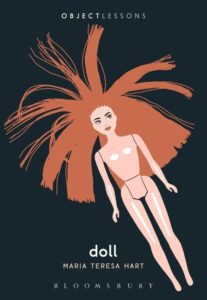
Maria Teresa Hart, writer and editor with articles and essays in The New York Times, The Atlantic, Vox, The Washington Post, and Teen Vogue, has just released her debut nonfiction book, Doll, published as part of Bloomsbury’s Object Lessons series (November, 2022). The Object Lessons book series is designed to feature everyday objects as an examination of broader truths in our culture. Doll is part history, part cultural critique, and part theatrical script, with pages of imagined playdates and even functional paper dolls.
Hart analyzes dolls—from 17th century Japanese figures in the Hinamatsuri festival, to the ‘80s American Girl Dolls, to today’s bitmoji expressions—as objects that society uses to encourage girls to become women. Allison Horrocks of the Dolls of Our Lives Podcast (who Hart and I discuss in the following conversation) called it a “heartfelt, intimate, and clever study of objects that terrify some and thrill others. Maria Teresa Hart answers the question, ‘What makes dolls so special, anyway?’ while giving us new perspective on these tiny, fragile mirrors.”
I spoke with Maria Teresa Hart via Zoom about Dolls, how feminism and pop culture have changed the market and sexualized the tokens of a girl’s playtime, which American Girl is most like us, and what sinister thoughts really exist in the mind of a doll.
***
The Rumpus: I know you wrote two Object Lessons essays for The Atlantic about bidets and hairdryers. How did you decide to pitch them the idea for Dolls as an Object Lessons book?
Maria Teresa Hart: I’m fascinated as a writer with the idea of taking an object and going deep on all the hidden messages and societal meaning behind it. Interestingly both hairdryers and bidets connected to feminine identity, or how women are perceived by society at large. Bidets have a really interesting history behind them that relates to femininity and how women are perceived. Hidden history is something that I’m quite interested in.
In terms of those essays, I did feel, when I finished writing them, there was not a book there, but I was captivated by the series and I did really want to write a book. I read Summer Brennan’s High Heel and that was the first moment where I really felt a fire lit inside me. Although I write about my personal history with dolls, which goes really, really deep, dolls didn’t come to me as a topic for a book for quite some time. I think for some funny reason, because it’s so obvious and so centered in my life. I realized: I have all this weird, deep knowledge about dolls.
Rumpus: I’m really interested in the way feminism and pop culture intersect, and specifically the ways in which ‘90s feminism—in which I grew up—was often dismissive of pop culture that appeals to young women and girls as frivolous or harmful. Are there ways in which you feel like your book is complicating or pushing back on some of these notions?
Hart: Absolutely! I’m of the same generation. I grew up with ‘90s feminism, and I was a very angry little punk rock girl. Back in the day, I was a riot grrrl who had my zine, and listened to my angry music. I think that wave of feminism did complicate things a little bit more. We were pushing back on some of those second-wave notions about sex, work, and the ideas of traditional femininity being dismissed; that women needed to move towards a more masculine framework in order to be to have our accomplishments seen. I think, for me, there was a little more of a mixed bag when it came to feminism. I remember having a lot of anger and complicated feelings towards Barbie: She was the epitome of this patriarchal society that was pushing a certain body type on us, including a lot of horrible body issues. I think there was a lot of well-placed societal anger about Barbie. But at the same time, I do think that there was this blaming of hyper-femininity, the femme, and the icons that went along with that.
I was thinking of this meme from the early days of the internet, with a photo of a bunch of little girls playing dress-up. Most were dressed up as princesses, but one of them [was dressed] as Darth Vader. The caption was: “Be the Darth Vader you want to see in the world.” Everyone was applauding this one little girl, as if she wasn’t falling for the princess malarkey. Oh, she is a little girl that is standing in her own power! She’s a little girl that wants to run an empire even though it’s…
Rumpus: …an evil empire?
Hart: Yes! We can laugh about how the meme was pointing its finger at corporate feminism, but you can also see the ideals that are held up are no better. Oh, sure, don’t be feminine, run a super-evil empire! The unspoken thing in that meme was that being a princess is bad, or maybe being ultra feminine is bad.
Rumpus: Yeah, that resonates so much with me. I identified very firmly as a feminist, maybe as a reaction to an ‘80s aesthetic, but I was more into the Indigo Girls vibe, rather than the riot grrrl thing.
Hart: I also had that album.
Rumpus: I started college in 2000 in the first era of Britney Spears or Christina Aguilera, that generation of singers who were more glamorous and more sexual. Your book asks an important question: How does the object, the doll, speak to broader cultural attitudes?
Hart: When you’re talking about your little girl dressing up like a princess, we know what the appeal is there. This is such a joyful fun expression of femininity and playtime! It’s such a shame that feminism had to put itself in contrast to that: No, we’re going to be serious. Then there are examples of Britney Spears and Christina Aguilera as women who have reached the pinnacle of the hierarchy that decides what a woman should be: young, sexualized, available, and commodified. They were presented physically, in a certain way. So, there’s this righteous anger about it, and a feeling of, Why isn’t this person taking themselves seriously? Why aren’t they engaging in things that are less superficial? Then again, who doesn’t like “Oops, I Did It Again”? Who doesn’t want to dance around with a feather boa? These are things that present joy in the world. Our anger should be placed more on these systems that don’t allow for any spectrum of womanhood. Dolls are placed at one specific pinnacle, like Barbie, representing Britney Spears’ version of femininity, and allow us to play with that, try it on, and to feel the fantasy.
Sometimes people suggest: What if Barbie did a Rosa Parks doll? I would say to them: “No way in hell are little girls going to play with that doll!” I’m sorry, but no. That doll would be for an adult market, and the adult market is based on nostalgia and revisionist history. We played with “Day to Night Barbie” or “Peaches and Cream Barbie,” but as adults, we think, Oh, I wish they made a Barbie that was a little more intellectual. We want to embrace these higher values. Kids know when toys are moral homework, and they know when the fun factor is gone. Those extremes of the fantasy of Barbie are what people are drawn to. We would be neglectful not to notice that. That’s the space of joy of creativity, and of fun.
Rumpus: I was thinking about the American Girl dolls, which you write about. I had Samantha and I read all of her books.
Hart: I just want to say I was also a Samantha.
Rumpus: My daughter has a Samantha too. We have two Samanthas, which is the most absurd and yet perfect example of consumerism…
Hart: Two generations of Samantha in one house!
Rumpus: The American Girl dolls feel totally asexual in a very safe way, even though they’re probably marketed at a relatively similar age group to Barbie, a trope of sexualized femininity. How developmentally appropriate is it for kids, who are maybe at the tail end of doing a lot of doll playing, to be acting out their own sexual feelings with these dolls?
Hart: The sexual appeal of Barbie is very much baked in. Little, little kids understand that that is a sexual doll. With the American Girl dolls, as you mentioned, they’re built to be a twin, a mini-me. So, they are meant to be this eight-year-old girl. Eight-year-olds do play with Barbie, as you said, but kids get Barbie and they get the message. They’re looking at a very voluptuous figure: Oh, this is a sexualized woman. Of course, we don’t treat little girls with that lens at eight years old, thank God.
And yet, the American Girl dolls still contain all kinds of other messages I explore in the book. Samantha heroically throws away a speech that she was going to make, about how factories are so great, and instead reads a speech all about how her little friend Nellie is being abused and victimized by the factory culture. This is a time where labor rights are non-existent, and Samantha’s out there, a voice of one, fighting for her friend, fighting for the workers. To me as a kid, that was so seductive! Oh, here’s a girl my age and she’s making a difference! That’s a really common storyline in the American Girl books, something we can feel really good about, potentially, as adults handing the message on to girls. So much of the media before that depicted girls as being passive. This is ‘90s feminism again: Girls can be the hero in their own story. Of course the downfall of that is how Samantha was centered in that story. Samantha was the person that saved the day, not Nellie. There’s a class question there. Nellie is the one laboring in the factory, but it takes someone upperclass, like Samantha, who’s positioned in society. The other thing that that is very troubling and that we can examine, is that the books have a narrative of white feminism. Oftentimes, it is a white person, a white young girl that saves the day. Narratives like this, where one individual is empowered, have much less sense of the community coming together. When it is always about one lone individual, without community struggles or trials, it resembles a story that’s been collected and transferred over from male heroes’ stories. We’re very much taking that text, changing the sex, and moving it over to the column of: “This is what’s going to empower little girls.”
That’s not the way the world works, and that’s not the way the labor movement worked. I mean, if you’re going to take the example from Samantha’s story, ask the question: “What changed labor laws? What got us to an eight-hour workday?” It was the collective.
Rumpus: What kind of contradictions did you find yourself most drawn to when researching and writing Doll?
Hart: One of the contradictions is the push/pull of being very attracted and drawn to dolls but also scared and repulsed by them.
A lot of ink has been spilled over the uncanny valley: something that is human-like, but is still just off enough to be eerie, and to set off our alarm bells. They have that chilling creep-factor of, “Wait a second….” You get close and you think, “Oh, that’s a human being,” but then your brain is scrambled: “No, it’s not!” You want to back away.
I think that’s a very common way of explaining, and maybe even dismissing, what makes dolls creepy. I actually think that there are a number of factors at play in terms of the creep-factor. First of all, older dolls, far and away the ones that creep people out the most, have evidence of a life gone by. Oftentimes, they even have human hair and human eyelashes. They have maybe hand-stitched outfits, so you’ll see that imperfect stitch. You see the fingerprints of another little girl all over this object, and that’s deeply creepy of course—evidence even of a human body that was put into it.
To take that a step further, we can acknowledge that maybe the factories that made these dolls were horrible places. Maybe the place where this object was being put together, especially if it’s old enough, was during a time when child labor was a common thing.
The doll that everyone points to as being the archetype of creepy dolls is Chucky, which was based on a doll called “My Buddy,” and marketed to little boys. I think that was a huge kind of disturbing horror thing for people. Dolls being put into the hands of little boys, or that a little boy can be a doll, is the ultimate in terms of scary/creepy.
Rumpus: Why is it that the frightening iteration of masculinity we’re imagining is something violent and aggressive and the most feminine terror is something about a connection to the past?
Hart: I have a theory about this. I think something is at play with little girl dolls, and the sinisterness behind them is a projection of some kind of selfhood onto the doll. We imagine they have feelings, they have independent thoughts, and yet, they are still a passive object that we can dress and undress. We can do whatever we want, at will, with them. We talked about Barbies, putting them in sexual situations, and I think there is an understanding that no human being would sign up for that. No person would endure that without this ocean of rage underneath them. So, I do think that there’s this sort of understanding of the dolls’ revenge. The passive doll object endures so much and has to be subservient and has to be put in sexual situations. There’s an idea that they would not endure that without having rage and violence. There are violent thoughts underneath. There’s a retribution, or reckoning that’s going to come, and we’re waiting for that volcanic explosion.
Rumpus: You told me once that people often want you to come down firmly on one side of a divide, like if Barbie is good or bad. I wondered if there were any other divides people expected you to cross?
Hart: Barbie is such a flashpoint, but I will mention the pressure I feel to acknowledge that dolls are creepy. I obviously don’t have that take, because I don’t feel that way. One of the ways that I try to work on my empathy for that perspective, is to sometimes think to myself: “If someone had told me they had written a book on clowns, which I find creepy and weird and off-putting, how would I react to that?” In the same way, I’d probably think: Come on! The point of the book is that clowns are creepy and awful, right?
Rumpus: Were there entire topics of doll history or culture that you couldn’t include? How did you decide what made the cut?
Hart: I chose to focus specifically on the US doll market, and the last century of the US doll market. I touch, occasionally, on a couple of other cultures that do use dolls, like Japan and their doll day [Hinamatsuri]. It’s a setup for an example that relates to the American Girl doll, just to give that lens for viewing how this type of doll play has existed for centuries. I do a similar setup with an ancient Roman crypt that was unearthed with a jointed doll there. It’s another moment of trying to give depth, but I really tried to keep the lens firmly on the last hundred years in this country. I was really conscious of the fact that even though this is a book that has a crossover academic audience, it better be entertaining. This is part of the reason I open this book with Barbie. I did not want to open with porcelain dolls—even though, chronologically, that would have made sense—because porcelain dolls are alienating. They just don’t relate to people’s lives right now.
Rumpus: What are some of the things about dolls, or doll-playing, that you find particularly fascinating?
Hart: One thing is how the messaging about dolls is so strongly pegged to femininity and to girlhood. Some conservative parents might see their little boy pick up a doll, and they will swat that doll out of his hands like it is radioactive, because Nope, nope, nope, these messages are not for you! Don’t get any ideas! There is a lot that happens when little kids who are not girls play with dolls. It’s in that moment where kids can flip the script.
The other thing that I find fascinating is that sometimes we have these moments where little kids, who are not girls, can see the messaging more clearly. I don’t think they would ever be able to articulate it this way, but I think they see it: “Oh, this is propaganda!” or “This is just a fantasy!” At the same time, it is a place where these kids can try on femininity and maybe find some identification there. When I write about girls in this book, I’m using the term in the most inclusive way because trans girls are girls, and trans girls, when they are misgendered as children and they play with dolls, there is often a moment of: A-ha! I finally found this representation of myself! which is also very valid and very interesting. That’s something I don’t get a chance to explore too much in the book.
***
Author photo by Stefanie Cole Photography






